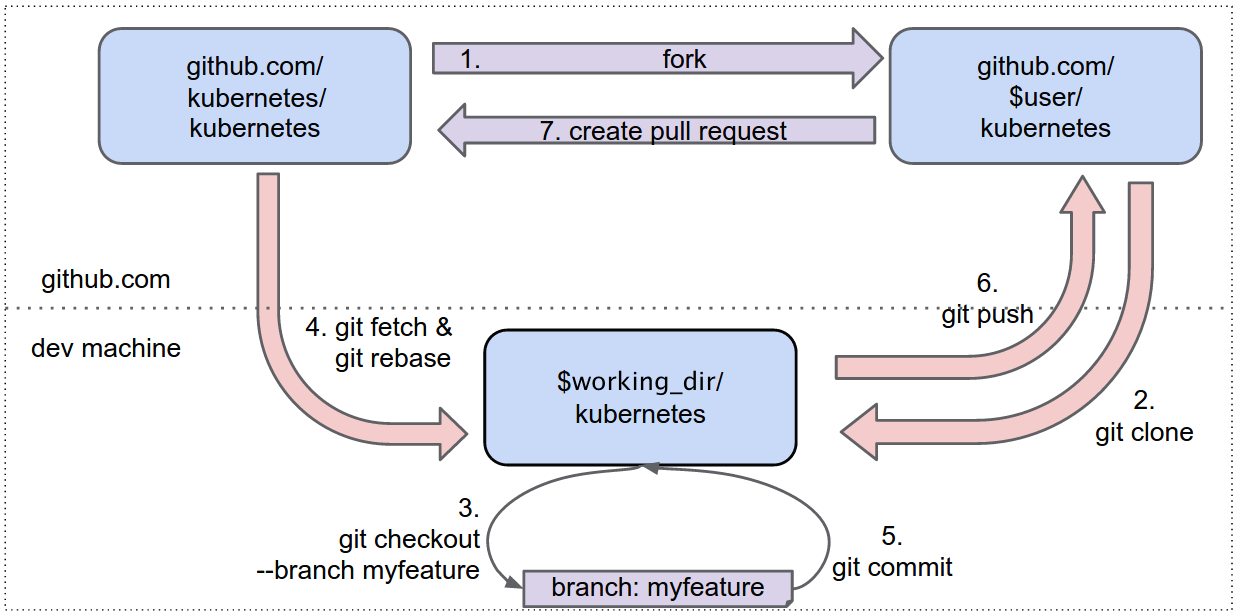This document is the canonical source of truth for things like supported toolchain versions for building Kubernetes.
Please submit an issue on github if you
- find a requirement that this doc does not capture,
- find other docs with references to requirements that are not simply links to this doc.
This document is intended to be relative to the branch in which it is found.
Development branch requirements will change over time, but release branch requirements are frozen.
Official releases are built using Docker containers. To build Kubernetes using Docker please follow [these instructions] (http://releases.k8s.io/HEAD/build/README.md).
Kubernetes development helper scripts assume an up-to-date GNU tools environment. Most recent Linux distros should work out-of-the-box.
Mac OS X ships with outdated BSD-based tools. We recommend installing Os X GNU tools.
Kubernetes maintains state in etcd, a distributed key store.
Please install it locally to run local integration tests.
Kubernetes is written in Go. If you don't have a Go development environment, please set one up.
| Kubernetes | requires Go |
|---|---|
| 1.0 - 1.2 | 1.4.2 |
| 1.3, 1.4 | 1.6 |
| 1.5 and higher | 1.7 - 1.7.5 |
| 1.8 not verified as of Feb 2017 |
After installation, you'll need GOPATH defined,
and PATH modified to access your Go binaries.
A common setup is
export GOPATH=$HOME/go
export PATH=$PATH:$GOPATH/binUpgrading Go requires specific modification of some scripts and container images.
- The image for cross compiling in build/build-image/cross.
The
VERSIONfile andDockerfile. - Update dockerized-e2e-runner.sh to run a kubekins-e2e with the desired Go version.
This requires pushing the e2e and test images that are
FROMthe desired Go version. - The cross tag
KUBE_BUILD_IMAGE_CROSS_TAGin build/common.sh.
Kubernetes build/test scripts use godep to
manage dependencies.
go get -u github.com/tools/godepCheck your version; v63 or higher is known to work for Kubernetes.
godep versionDevelopers planning to manage dependencies in the vendor/ tree may want to
explore alternative environment setups. See using godep to manage dependencies.
- Visit https://github.com/kubernetes/kubernetes
- Click
Forkbutton (top right) to establish a cloud-based fork.
Per Go's workspace instructions, place Kubernetes' code on your
GOPATH using the following cloning procedure.
Define a local working directory:
# If your GOPATH has multiple paths, pick
# just one and use it instead of $GOPATH here
working_dir=$GOPATH/src/k8s.ioIf you already do Go development on github, the
k8s.iodirectory will be a sibling to your existinggithub.comdirectory.
Set user to match your github profile name:
user={your github profile name}Both $working_dir and $user are mentioned in the figure above.
Create your clone:
mkdir -p $working_dir
cd $working_dir
git clone https://github.com/$user/kubernetes.git
# or: git clone [email protected]:$user/kubernetes.git
cd $working_dir/kubernetes
git remote add upstream https://github.com/kubernetes/kubernetes.git
# or: git remote add upstream [email protected]:kubernetes/kubernetes.git
# Never push to upstream master
git remote set-url --push upstream no_push
# Confirm that your remotes make sense:
git remote -vPlease link the Kubernetes pre-commit hook into your .git directory.
This hook checks your commits for formatting, building, doc generation, etc.
It requires both godep and etcd on your PATH.
cd $working_dir/kubernetes/.git/hooks
ln -s ../../hooks/pre-commit .Get your local master up to date:
cd $working_dir/kubernetes
git fetch upstream
git checkout master
git rebase upstream/masterBranch from it:
git checkout -b myfeatureThen edit code on the myfeature branch.
cd $working_dir/kubernetes
makeTo build with optimizations disabled for enabling use of source debug tools:
make GOGCFLAGS="-N -l"To build binaries for all platforms:
make crosscd $working_dir/kubernetes
# Run every unit test
make test
# Run package tests verbosely
make test WHAT=pkg/util/cache GOFLAGS=-v
# Run integration tests, requires etcd
make test-integration
# Run e2e tests
make test-e2eSee the testing guide and end-to-end tests for additional information and scenarios.
# While on your myfeature branch
git fetch upstream
git rebase upstream/masterCommit your changes.
git commitLikely you go back and edit/build/test some more then commit --amend
in a few cycles.
When ready to review (or just to establish an offsite backup or your work),
push your branch to your fork on github.com:
git push -f origin myfeature- Visit your fork at https://github.com/$user/kubernetes (replace
$userobviously). - Click the
Compare & pull requestbutton next to yourmyfeaturebranch. - Check out the pull request process for more details.
If you have upstream write access, please refrain from using the GitHub UI for creating PRs, because GitHub will create the PR branch inside the main repository rather than inside your fork.
Once your pull request has been opened it will be assigned to one or more reviewers. Those reviewers will do a thorough code review, looking for correctness, bugs, opportunities for improvement, documentation and comments, and style.
Commit changes made in response to review comments to the same branch on your fork.
Very small PRs are easy to review. Very large PRs are very difficult to review.
At the assigned reviewer's discretion, a PR may be switched to use Reviewable instead. Once a PR is switched to Reviewable, please ONLY send or reply to comments through reviewable. Mixing code review tools can be very confusing.
See Faster Reviews for some thoughts on how to streamline the review process.
Upon merge (by either you or your reviewer), all commits left on the review branch should represent meaningful milestones or units of work. Use commits to add clarity to the development and review process.
Before merging a PR, squash any fix review feedback, typo, and rebased sorts of commits.
It is not imperative that every commit in a PR compile and pass tests independently, but it is worth striving for.
For mass automated fixups (e.g. automated doc formatting), use one or more commits for the changes to tooling and a final commit to apply the fixup en masse. This makes reviews easier.
